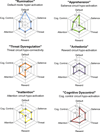Defining biotypes for depression and anxiety based on large-scale circuit dysfunction: a theoretical review of the evidence and future directions for clinical translation
- PMID: 27653321
- PMCID: PMC5702265
- DOI: 10.1002/da.22556
Defining biotypes for depression and anxiety based on large-scale circuit dysfunction: a theoretical review of the evidence and future directions for clinical translation
Abstract
Complex emotional, cognitive and self-reflective functions rely on the activation and connectivity of large-scale neural circuits. These circuits offer a relevant scale of focus for conceptualizing a taxonomy for depression and anxiety based on specific profiles (or biotypes) of neural circuit dysfunction. Here, the theoretical review first outlines the current consensus as to what constitutes the organization of large-scale circuits in the human brain identified using parcellation and meta-analysis. The focus is on neural circuits implicated in resting reflection (default mode), detection of "salience," affective processing ("threat" and "reward"), "attention," and "cognitive control." Next, the current evidence regarding which type of dysfunctions in these circuits characterize depression and anxiety disorders is reviewed, with an emphasis on published meta-analyses and reviews of circuit dysfunctions that have been identified in at least two well-powered case:control studies. Grounded in the review of these topics, a conceptual framework is proposed for considering neural circuit-defined "biotypes." In this framework, biotypes are defined by profiles of extent of dysfunction on each large-scale circuit. The clinical implications of a biotype approach for guiding classification and treatment of depression and anxiety is considered. Future research directions will develop the validity and clinical utility of a neural circuit biotype model that spans diagnostic categories and helps to translate neuroscience into clinical practice in the real world.
Keywords: anxiety/anxiety disorders; biological markers; brain; depression; functional MRI; imaging/neuroimaging; mood disorders.
© 2016 Wiley Periodicals, Inc.
Figures



Similar articles
-
Developing a clinical translational neuroscience taxonomy for anxiety and mood disorder: protocol for the baseline-follow up Research domain criteria Anxiety and Depression ("RAD") project.BMC Psychiatry. 2016 Mar 15;16:68. doi: 10.1186/s12888-016-0771-3. BMC Psychiatry. 2016. PMID: 26980207 Free PMC article.
-
Mapping Neural Circuit Biotypes to Symptoms and Behavioral Dimensions of Depression and Anxiety.Biol Psychiatry. 2022 Mar 15;91(6):561-571. doi: 10.1016/j.biopsych.2021.06.024. Epub 2021 Jul 11. Biol Psychiatry. 2022. PMID: 34482948 Free PMC article.
-
Decreased amygdala-insula resting state connectivity in behaviorally and emotionally dysregulated youth.Psychiatry Res. 2015 Jan 30;231(1):77-86. doi: 10.1016/j.pscychresns.2014.10.015. Epub 2014 Nov 14. Psychiatry Res. 2015. PMID: 25433424 Free PMC article.
-
Peril and pleasure: an rdoc-inspired examination of threat responses and reward processing in anxiety and depression.Depress Anxiety. 2014 Mar;31(3):233-49. doi: 10.1002/da.22202. Epub 2013 Oct 21. Depress Anxiety. 2014. PMID: 24151118 Free PMC article. Review.
-
Precision psychiatry: a neural circuit taxonomy for depression and anxiety.Lancet Psychiatry. 2016 May;3(5):472-80. doi: 10.1016/S2215-0366(15)00579-9. Epub 2016 Apr 14. Lancet Psychiatry. 2016. PMID: 27150382 Free PMC article. Review.
Cited by
-
Impaired executive function exacerbates neural markers of posttraumatic stress disorder.Psychol Med. 2021 Apr 21:1-14. doi: 10.1017/S0033291721000842. Online ahead of print. Psychol Med. 2021. PMID: 33879272 Free PMC article.
-
Challenges of Mood Disorders Care.Focus (Am Psychiatr Publ). 2020 Apr;18(2):205-207. doi: 10.1176/appi.focus.18202. Epub 2020 Apr 23. Focus (Am Psychiatr Publ). 2020. PMID: 33162860 Free PMC article. No abstract available.
-
Effects of Cortisol Administration on Resting-State Functional Connectivity in Women with Depression.Psychiatry Res Neuroimaging. 2024 Jan;337:111760. doi: 10.1016/j.pscychresns.2023.111760. Epub 2023 Nov 26. Psychiatry Res Neuroimaging. 2024. PMID: 38039780 Free PMC article. Clinical Trial.
-
Social Dysfunction and Neural Processing of Emotional Valence Across Depressive and Anxiety Disorders.Depress Anxiety. 2024 Oct 10;2024:8564344. doi: 10.1155/2024/8564344. eCollection 2024. Depress Anxiety. 2024. PMID: 40226699 Free PMC article.
-
Edge-centric connectome-genetic markers of bridging factor to comorbidity between depression and anxiety.Nat Commun. 2024 Dec 4;15(1):10560. doi: 10.1038/s41467-024-55008-0. Nat Commun. 2024. PMID: 39632897 Free PMC article.
References
-
- Substance Abuse and Mental Health Services Administration. Results from the 2012 National Survey on Drug Use and Health: Mental Health Findings. Rockville, MD: 2013.
-
- Whiteford HA, Degenhardt L, Rehm J, et al. Global burden of disease attributable to mental and substance use disorders: findings from the Global Burden of Disease Study 2010. Lancet. 2010;382(9904):1575–1586. - PubMed
-
- Insel T, Cuthbert B, Garvey M, et al. Research domain criteria (RDoC): toward a new classification framework for research on mental disorders. Am J Psychiatry. 2010;167(7):748–751. - PubMed
-
- Yuste R. From the neuron doctrine to neural networks. Nat Rev Neurosci. 2015;16(8):487–497. - PubMed
Publication types
MeSH terms
Grants and funding
LinkOut - more resources
Full Text Sources
Other Literature Sources
Medical
Molecular Biology Databases

